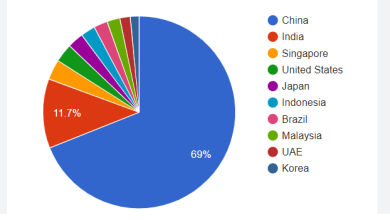Explaining Optical and Laser Sensors: What to Know in Bangladesh

Imagine standing at the edge of a technological frontier, where optical and laser sensors could reshape industries in Bangladesh. You might wonder how these devices translate light and precise beams into essential data that drive efficiency and innovation. Understanding their workings and applications is critical, especially considering the unique challenges the country faces. As you explore the nuances of these sensors, you’ll uncover not just their benefits but also the barriers that could hinder their adoption. What lies ahead in this evolving landscape, and how can you be part of the change?
Key Takeaways
- Optical sensors detect light and convert it into electrical signals, enhancing data accuracy across various applications in Bangladesh.
- Laser sensors utilize focused beams for precise measurements, crucial for industrial automation and environmental monitoring in the country.
- Key applications of laser sensors include air quality monitoring, medical diagnostics, and quality control in manufacturing processes.
- Challenges in Bangladesh include technical infrastructure, maintenance issues, and budget constraints that can hinder sensor implementation.
- Future trends indicate increasing demand for advanced sensors driven by automation, AI integration, and consumer preferences for high-quality devices.
Definition of Optical Sensors
Optical sensors are devices that detect and measure light, converting optical signals into electrical signals for analysis. These sensors utilize advanced technology to provide accurate and real-time data in various applications. You’ll find them in fields like telecommunications, environmental monitoring, and industrial automation, where precision is key. Recent optical innovations have greatly enhanced their performance, enabling better sensitivity and faster response times. By leveraging principles like photodetection and light modulation, optical sensors can operate under diverse conditions, making them invaluable in modern systems.
As you explore the landscape of sensor technology, it’s interesting to note how similar precision is required in the design and functionality of devices like a gaming mouse or a wireless mouse.
The efficiency and reliability of optical sensors play an important role in driving advancements across multiple industries, paving the way for future developments.
Definition of Laser Sensors
Laser sensors detect and measure light using focused beams of coherent light, transforming the properties of laser signals into actionable data. These sensors offer exceptional accuracy, making them indispensable in various applications, from industrial automation to environmental monitoring. While optical sensors provide versatility in detecting a wide range of light wavelengths, laser sensors specialize in high-precision measurements.
| Feature | Laser Sensors | Optical Sensors |
| Measurement Range | Short to long distances | Varies, often broader |
| Precision | High accuracy | Moderate accuracy |
| Application | Industrial, scientific | Consumer electronics, safety |
In the realm of consumer electronics, the precision of devices like the wireless mouse can be enhanced by the principles of laser technology, ensuring a responsive and accurate user experience. Overall, laser sensors stand out for their ability to provide reliable measurements in critical applications, akin to how specialized gaming equipment, such as a gaming mouse, can elevate performance in competitive scenarios.
How Optical Sensors Work
A fundamental aspect of how optical sensors operate lies in their ability to convert light into electrical signals. Optical sensors utilize various components like photodiodes and charge-coupled devices to detect light intensity. When light hits these components, it generates electron-hole pairs, leading to a measurable electrical current. This process is essential in sensor technology, as it directly impacts data accuracy.
By analyzing the generated signals, you can derive precise measurements of light levels, colors, or even distances, depending on the application.
For instance, similar to how different types of mice like a wireless mouse can enhance user experience through efficient tracking technology, optical sensors can enhance data collection in various fields. Factors like wavelength sensitivity and response time further enhance the reliability of these sensors. Understanding their operational principles allows you to leverage optical sensors effectively in various industries, ensuring optimal performance and accurate data collection.
In the same way that gamers rely on specialized equipment like a gaming mouse for precision, industries depend on optical sensors for accurate measurements. This synergy between technology ensures that data collection and performance meet the highest standards.
How Laser Sensors Work
Three key components define how laser sensors operate: a laser source, a beam splitter, and a detector. The laser source emits a coherent beam of light, which travels towards a target. When this beam interacts with the target, it reflects back to the sensor.
The beam splitter divides the incoming light, allowing some to reach the detector while directing the rest for further analysis. This process enables precise measurements of distance, speed, and position, essential in various applications including high-tech devices like a wireless mouse.
Applications of Optical Sensors
In various industries, optical sensors play an important role in enhancing operational efficiency and accuracy. In automotive safety, these sensors are vital for collision avoidance systems, enabling real-time detection of obstacles and pedestrians, thereby reducing accidents. By utilizing light to gauge distance and speed, they greatly improve vehicle safety features.
In consumer electronics, optical sensors are integral to devices like smartphones and cameras, facilitating functions such as autofocus and gesture recognition. Their ability to detect light levels allows for automatic brightness adjustments, enhancing user experience.
For instance, the precision offered by optical sensors is comparable to the responsiveness found in a high-quality wireless mouse, which enhances user interaction with devices.
Additionally, optical sensors contribute to smart home technologies, enabling seamless interaction between devices. By integrating these sensors, industries can achieve greater precision and reliability in their applications, ultimately driving innovation and growth.
The advancements seen in optical technology reflect the same level of innovation that’s present in the latest gaming mouse designs, which utilize cutting-edge technology to improve user experience.
Applications of Laser Sensors
Laser sensors play an important role in various applications, including industrial measurement, where precision is paramount. In environmental monitoring, these sensors provide real-time data critical for evaluating air and water quality. Additionally, in medical diagnostics, laser technology is revolutionizing how we detect and analyze health conditions, enhancing both accuracy and efficiency.
Industrial Measurement Applications
Utilizing advanced laser sensor technology, industries in Bangladesh are enhancing their measurement capabilities across various applications. In the field of industrial automation, laser sensors provide precise measurements important for optimizing production processes. These sensors enable accurate distance, position, and dimensional measurements, which are essential for maintaining quality control.
By integrating laser sensors into automated systems, you can greatly improve efficiency and reduce errors. Moreover, the data collected by these sensors facilitates in-depth data analysis, allowing for real-time monitoring and informed decision-making.
This analytical approach empowers industries to adapt quickly to changing conditions, ultimately maximizing productivity and profitability. Embracing laser sensor technology is necessary for staying competitive in today’s rapidly evolving industrial landscape.
For companies looking to enhance their operational efficiency, exploring various technological solutions, much like how one would consider different types of computer peripherals such as a wireless mouse or gaming mouse, can be vital in driving innovation and success.
Environmental Monitoring Uses
Environmental monitoring employs laser sensors to provide accurate data on air quality, water levels, and land use. You can utilize these sensors to gauge air quality by measuring particulate matter and gas concentrations, ensuring compliance with environmental regulations. By integrating laser technology, real-time monitoring becomes feasible, allowing for swift responses to fluctuations in air pollution levels.
Additionally, laser sensors are instrumental in detecting water pollution. They can assess turbidity and chemical contaminants in water bodies, providing essential insights for environmental management. The precision of laser measurements enhances your ability to identify pollution sources, enabling targeted interventions.
Overall, the application of laser sensors in environmental monitoring fosters a proactive approach to maintaining ecological balance and protecting public health.
For those interested in innovative technology, just as you’d choose a high-performance gaming mouse for precision in gaming, the precision of laser measurements enhances monitoring capabilities. Similarly, having the right tools for environmental management is crucial. By utilizing laser sensors effectively, you can ensure a healthier environment and a better understanding of ecological impacts.
Medical Diagnostics Innovations
As advancements in technology shape various fields, the application of laser sensors in medical diagnostics is transforming healthcare practices. These sensors enable precise measurements of biological parameters, facilitating early disease detection. By integrating machine learning algorithms, you can analyze vast datasets, enhancing diagnostic accuracy and predictive capabilities. This synergy allows for personalized treatment plans, improving patient outcomes.
Additionally, telemedicine integration leverages laser sensor data, enabling remote monitoring and consultations. You’ll find that patients benefit from real-time feedback, and medical professionals gain access to inclusive data, regardless of location.
The fusion of laser sensors with cutting-edge technologies positions healthcare for significant improvements, making diagnostics faster, more efficient, and increasingly accessible.
Just as the selection of a quality device, such as a wireless mouse, can enhance productivity in technology, embracing these innovations is essential for modern medical practices. With the right tools and technologies, healthcare can achieve remarkable advancements that ultimately benefit patient care.
Advantages of Optical Sensors
Optical sensors frequently offer significant advantages in various applications, especially concerning sensitivity and accuracy. You’ll find that their ability to detect minute changes in light allows for precise measurements, which is essential in sensor technology. This high sensitivity enhances data collection, enabling you to gather reliable information in real-time across multiple environments.
In addition, optical sensors are less affected by electromagnetic interference than traditional sensors, improving their performance in complex settings. Their non-invasive nature allows for safe monitoring in medical diagnostics and environmental assessments. Moreover, they often require less maintenance and have a longer lifespan, making them cost-effective in the long run.
Just as the precision of optical sensors is crucial in various fields, the choice of a reliable mouse can also enhance user experience in technology. For instance, a quality wireless mouse offers the freedom of movement without the hassle of cords. Additionally, brands like Logitech and Razer have developed advanced gaming mouse options that utilize similar principles of precision and responsiveness. Overall, optical sensors are indispensable tools in advancing various fields due to their exceptional performance metrics.
Advantages of Laser Sensors
Laser sensors provide a range of advantages that make them highly effective in various applications. Their precision accuracy is unmatched, allowing you to obtain exact measurements even over long distances. This capability is essential in fields like manufacturing and construction, where small errors can lead to significant issues.
In addition, laser sensors facilitate real-time monitoring, enabling you to track changes instantly and make informed decisions on the spot. This real-time data collection enhances process efficiency and reduces downtime, ultimately saving costs.
Their ability to operate in challenging environments, such as extreme temperatures or dusty conditions, makes them versatile. Overall, when you need reliable and accurate data, laser sensors stand out as a superior choice in technology.
For those looking to enhance their workflow, similar precision can be found in high-quality devices such as those available on MouseBD, offering a variety of options including wireless mice and gaming mice.
Challenges in Implementation
When implementing optical and laser sensors in Bangladesh, you’ll encounter significant challenges related to technical infrastructure limitations and cost constraints. These factors can hinder effective deployment and maintenance of such advanced technology. Understanding these obstacles is essential for developing strategies that can overcome them.
Technical Infrastructure Limitations
Implementing optical and laser sensors in Bangladesh encounters notable technical infrastructure limitations that hinder advancement. Bandwidth limitations restrict data transmission rates, complicating real-time monitoring and analysis. Furthermore, power constraints impede the dependable operation of these sophisticated technologies, which demand consistent energy sources.
| Challenge | Impact | Potential Solutions |
| Bandwidth Limitations | Slow data transfer, affecting response time | Upgrade network infrastructure |
| Power Constraints | Frequent downtime, reduced reliability | Invest in renewable energy sources |
| Maintenance Issues | Increased costs, operational delays | Establish local support services |
Addressing these limitations is crucial for the effective deployment of optical and laser sensors, ensuring they can cater to the demands of various applications in Bangladesh. For instance, similar challenges faced in the electronics sector, such as with gaming mouse technology, highlight the need for robust infrastructure to support advanced functionalities. Upgrading to a reliable network could also benefit various products available at MouseBD, including options like the wireless mouse and Bluetooth mouse.
Cost and Resource Constraints
The costs associated with deploying optical and laser sensors can create a significant barrier to entry for many organizations in Bangladesh. Achieving cost efficiency often involves tackling several challenges, including:
- High initial investment in technology
- Limited availability of qualified personnel
- Ongoing maintenance and operational expenses
- Variability in resource availability due to economic conditions
These factors can exacerbate technological limitations, making it difficult for organizations to implement effective solutions. Furthermore, practical considerations such as budget constraints complicate the deployment process.
As you explore the potential of optical and laser sensors, it’s crucial to evaluate your organization’s financial readiness and resource allocation to ensure sustainable implementation and long-term success.
For example, organizations might consider investing in cost-effective alternatives, such as a wireless mouse as a simple tool for improving operational efficiency in resource-constrained environments. Additionally, brands like Logitech offer various products that could serve as practical solutions for enhancing workflow without incurring substantial costs.
Future Trends in Bangladesh
Emerging technologies are poised to revolutionize the optical and laser sensor landscape in Bangladesh. As you analyze market projections, it’s evident that the demand for these sensors will surge significantly, propelled by advancements in automation and smart technologies across diverse sectors, including healthcare, agriculture, and manufacturing. You’ll see that technology advancements, especially in miniaturization and cost reduction, will enhance sensor capabilities, making them more accessible to local industries.
Moreover, the integration of artificial intelligence with optical sensors is anticipated to improve data accuracy and facilitate real-time decision-making. Keeping an eye on these trends will be essential for stakeholders aiming to leverage cutting-edge solutions that drive efficiency and innovation in Bangladesh’s evolving market.
For instance, just as the demand for high-quality devices like a wireless mouse reflects consumer preferences, the rising need for sophisticated sensors showcases the technological shift in various industries.
Embracing these advancements will position you ahead of the curve and allow you to tap into the transformative potential of these emerging technologies. As the market continues to evolve, staying informed will be crucial for success in harnessing the capabilities that modern optical sensors offer.
Conclusion
In the grand tapestry of technology, you’d think optical and laser sensors would be the stars, effortlessly guiding Bangladesh toward innovation. Yet, amid the promise of enhanced efficiency and precision, challenges linger like uninvited guests. As you navigate the complexities of implementation, remember: embracing these advanced tools isn’t just about keeping up; it’s about leading the charge into a brighter, more sustainable future. After all, who wouldn’t want to harness the power of light for progress?




